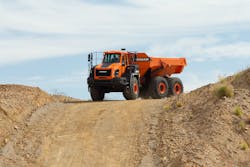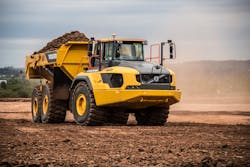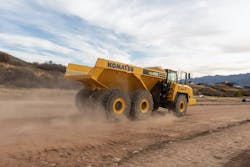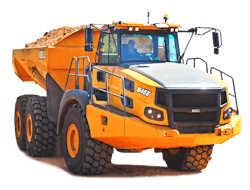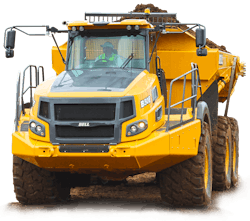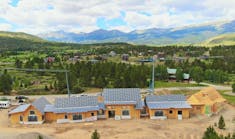Editor's Note: In the print and digital edition of this article, John Deere was erroneously connected to Bell Equipment with a punctuation error. John Deere is not affiliated with and has no relationship with Bell Equipment.
An articulated dump truck (ADT) or dump hauler is very large, utilized for transporting loads over rough terrain and, at times, on public roads. All-wheel drive typically comes with this equipment. Two basic units form the ADT, a front section, generally called the tractor, and a rear section containing the dump body—called the hauler or trailer section.
Steering pivots the front with the back through hydraulic rams. This way, all wheels follow the same path, making it an excellent off-road vehicle. Manufacturers include such names as John Deere, Caterpillar, Terex, Bell Equipment, Doosan, Volvo CE, and Komatsu Limited.
First imagined as something hauling aggregate and soil, dumpers or aggregate transporters went on to find work in such utilizations as agriculture, mining, construction, and highway maintenance. Specific functions range from concrete mixer, water tanker, and container truck, to upsize off-road semi-trailer hauler (on-road applications), hook loader, or crane, as well as uses in timber transport and even as a platform for wood-chipping. The vehicle's chassis has been used as well for military functions. It is only is surpassed by off-road tracked vehicles.
Adding Popular Technology Already Commonplace in Commercial Vehicles
Volvo had the first articulated dump truck back in 1966. Over the years, they added the technological advances we've come to expect in autos, trucks, and other equipment. “One of the big things developed included the auto co-pilot,” explains Rob Palermo, North American product manager for Volvo's articulated haulers. "This is the extra monitor up in the cab of the machines on excavators, wheel loaders. Then within that co-pilot, they have apps that relate to the model of the truck such as the excavator. For articulated haulers, the system has haul assist.
"We also have an onboard weighing system. A lot of work went into the development of that system after an earlier version was in place. Now, this technology takes all the data and puts it in the co-pilot display. Information streams in color through this cloud-based instrumentation, able to be downloaded in the office or someplace tracking daily production or what specifically is occurring at the job site.”
Among the apps involved with this system is something called Maps. "And more apps are being added so there is a real-time version of where everyone is on the job site.
“We get with the entire group and help the customers build a full map of their site, loading zones, dump zones, or warnings for one-way zones. A code placed into the system will come up with the correct map. It's in real-time showing them where they should go, what material goes where. All that stuff is in turn recorded, and personal data downloaded."
The Volvo Group, according to Palermo, is really big, actually the largest engine manufacturer in the world. "We are going to be adding even more apps to the co-pilot systems. These include tire pressure monitoring, weather apps, and a feature which is an office suite—all to make the operator of that truck understand what is going on.
“This is the future, artificial intelligence, including another feature, terrain memories. You take the truck around on the route and the system then remembers that differentials may be going from 4-by-4 to 6-by-6 wheels. It remembers that instead of getting ready to slip. On the next run, the system locks it up."
It will lock up ahead of where it locked up previously. So now you will go through that area smoothly while under stress or in a loaded situation. This configuration in turn resets every four hours, giving the operator a break in his thought process. Operators can, in turn, focus on the road and not worry about what mode they are in.
“We added full cruise control, too. You set the speed and go with that and fuel consumption is optimized. Also, there is a downhill cruise control. Thus, when an operator heads downhill there are no questions about downshifting—all they have to do is take their feet off the pedals and let the system do the rest.”
The truck controls that velocity and holds it at that rate going down the hill. Opti-shift on reverse wheel loaders allows shifting from forward to reverse automatically. With cruise control, while going downhill, speed is moderated and brakes preserved as well. A lot of training enables operator understanding of how systems work. Brake failures rarely occur and the system keeps brake as well as oil temperatures down.
“Operator-less machines are in the future. For now, our lifetime frame warranty puts our money where our mouth is in the production of one of the best products out there. And the younger generation of operators is quite comfortable with all the new technology. They've grown up with it. They love this kind of stuff. Older guys do not necessarily see the value. They have been driving all these years without it. However, younger managers want to know this kind of real-time information."
The above features result in more efficiency in the area of cost per ton as well as fuel efficiency. Volvo tries to make it simple. This is not too much information, according to Palermo. “This is not too much to understand so it's not too bad for those wondering about this new equipment.”
They also do operator training on their lateral support dumping system. This means if a driver attempts to dump a load at the wrong angle, the equipment will not follow through with the dump. Their core value remains safety. All of this has maintained total sales at the top.
Product Availability and Service Help with ADT Decision-Making
Keith Radford, owner of KR Trucking, LLC, in Gleason, TN, is now familiar with the equipment Doosan produces. "But before we got it we did have concerns,” explains Radford. “We mainly worried about dealership support. But after I talked to a Doosan representative, my confidence rose. Now, after using a number of trucks we find they're doing an excellent job.
“In Europe, ADTs are quite popular, but here in the US at least in our area of the country, they are not as established. I guess we went in a different direction.”
Radford needed a fleet of trucks to haul mining materials in western Tennessee. He feels he took a chance on Doosan. “The trucks, however, have proven themselves 100%,” adds Radford. “My four DA30-5 articulated dump trucks worked so well that I have ordered four more.
"The traction is amazing. We need it for the work we do in our business moving anywhere from 20 to 120 feet of overburden to get to our main product. Once they are done with that work, we come with our vocational dump trucks to mine and haul the ball clay that's extracted.
“We supply the raw material for a brick plant along with other places using the clay from this region of the state, for a little bit of everything. This includes tires, shingles, ceramics, and an astonishing number of other uses. I had little knowledge of their wide variety until I read an article written by someone at Doosan.”
Radford also uses his equipment to place the overburden they remove on roads constructed to mine the clay. Their haulers can traverse mud and slop while sometimes they drag the frames of the trucks with 20 yards of material if a person were to walk through it. This operation goes on all day long.
“The beds of the trucks may get unbalanced on slides. But we put the wide tires on them—especially good for flotation—as well as use bed liners.
“The liners let the material slide out without slipping as bad. We have a total of 22 off-road trucks, Volvos and Komatsus.”
The main reason for their search and then eventually going with Doosan was the service that they received on the equipment from the dealership. Another factor included truck availability for their operations when they needed them.
Other companies and dealerships had none immediately forthcoming. Some cases with certain manufacturers involved unavailable vehicles because they had been pre-sold. The bottom line is KR Trucking had its specific timeframe which unfortunately did not fit with some of the truck-makers, according to Radford.
“At the moment we have no intentions of expanding on the equipment side. Though too, that could change in the not-too-distant future. This is all playing out while the demand for our product holds steady or even grows as we ship our product to the many tile plants in mid-Tennessee. We haul the clay to the local processing plants nearby. Then some of the finished product they transport by truck to other plants as well.”
They haul material to Alabama, MS, and Mount Pleasant, TN. The raw material is best described as gray clay. "When processed, it does fire out into different colors. We are doing well, having started up in 2002, and now have some 70 to 80 employees. Thirty-seven of those work in the stripping operations and 32 drive the company's vocational dump trucks. At this point, everything is going great. We are really satisfied with the Doosan equipment we employ as well.”
Equipment Fine-Tuning Dovetails Into AI
Robert Hussey, Komatsu product marketing manager, points out Komtrax to his clients. Komtrax allows owners and fleet managers access to machine performance data such as fuel consumption, utilization, and production. These metrics can be used to lower owning and operating costs.
“Maintenance reminders and error codes are also reported so machine health can be monitored remotely,” adds Hussey. “All of this data can in turn be accessed via the web. Komtrax does not require a subscription and it is a no-cost feature.
“Our Payload meter (PLM) is a standard feature displaying payload tonnage on the machine monitor, so the truck operator is aware of the weight in the dump body. An external display lamp on the roof of the cab indicates to the loading tool operator when the payload has been reached. Payload data can be accessed via KOMTRAX as well as downloaded directly from the machine.”
Their equipment also features a rearview camera and dedicated color monitor in the operator's cab.
Komatsu’s articulated trucks are equipped with Komatsu Advanced Transmission with Optimum Modulation Control System (K-ATOMiCS), a six-speed, fully automatic transmission using an advanced electronic system to eliminate shift shock and torque cutoff.
This way, the engine operates in its most efficient range, all while the electronic system automatically selects the gear based on vehicle speed, engine speed, and the shift position selected. With each of these variables under control, the result is powerful acceleration, smooth downshifting, and synchronized engine speed when climbing slopes.
Komatsu has also incorporated automated systems that have been designed to increase braking and transmission performance in soft and slippery ground conditions without the need for operator input. Komatsu’s Traction Control System (KTCS) monitors wheel speeds and automatically engages and disengages wheel brakes individually, transferring power through the differential to the tire with the most traction.
"This feature operates without input from the operator,” adds Hussey. “And it will not compromise steering performance, which one might experience with a differential lock system.
“Komtrax closely tracks utilization (idle time)—for units that are being underutilized as well. That way, end users can investigate an opportunity to redeploy or repurpose assets to areas of the job site where they will have higher utilization. The payload meter ensures haul trucks are being loaded to their rated capacity. This data, in turn, is then available in real-time to the haul truck operator, the loading tool operator via external display lamps, and fleet manager via Komtrax, Komatsu’s complimentary telematics system.”
The PLM is also used to ensure that trucks are not being overloaded, which can result in unnecessary component wear. The electronically controlled transmission automatically upshifts or downshifts depending on the application demand, resulting in superior performance on grade.
As with much else in the world, even ADTs may be ripe for automation or artificial intelligence. “Komatsu has a host of experience to pull from when it comes to fully automated equipment,” says Hussey. “This is from autonomous haulage systems to intelligent Machine Control dozers and excavators. There is a significant amount of potential for complete automation in articulated trucks. However—bottom lines always remind us— this technology will ultimately be driven by market demand and customer needs.”
Fine-Tuning Automation to Meet Needs Found Onsite
New on the 410E-II and 460E-II Articulated Dump Trucks, John Deere has added three easily selectable drive modes—Normal, ECO, and Traction, according to Justin Steger, solutions marketing manager, site development and underground with John Deere. “These new drive modes take the guesswork out of tractive effort and can be changed as job site conditions change,” says Steger. “The modes include Normal, Eco, and Traction. Normal Mode is for typical operation, delivering results similar to the previous E-Series models.
“When conditions allow it, Eco Mode helps to reduce fuel consumption by smoothing throttle input, reducing maximum rpm, and optimizing transmission response. Finally, Traction Mode enhances the ability of the machine to maintain traction in soft and slippery underfoot conditions by applying additional control to the automated differential lock system and powertrain.”
Additionally, John Deere changed from radar to wheel speed sensors to help with even more timely engagement of differential lock on the fly, no matter which drive mode the operator chooses. Finally, John Deere made updates to the cab across all models to include optional Automatic Temperature Control and optional Heated and Ventilated premium suspension seats.
“We put a lot of effort into delivering a machine that makes operators safe and productive, regardless of their skill level,” explains Steger. “We also simplified the transmission retarder modes on 410E-II and 460E-II. This way, the transmission retarder can be set to an aggressiveness level matching the job site and the operator’s driving style.
“Regardless of the transmission retarder setting, any time the service brakes are used, the retarder acts on the driveline at 100 percent, saving wear on the brakes. Depending on the job site terrain, automatic descent control also makes use of the transmission retarder.
“Additionally, on the new E-IIs, we automated many of the tasks required of an operator on a job site. Features such as Auto Horn, Auto Dump, Downhill Dump, Hill Hold, and Dump Body Down Protection, in addition to multiple owner and operator sites limit settings such as speed limits, body height limit, rollover protection, and bin speed restriction (spreading material), make operation easy while increasing productivity."
As for telematics, the John Deere suite of construction technology delivers productivity solutions to help customers get more done, more efficiently. The five-year in-base, JDLink telematics subscription provides machine location, utilization data, and alerts to maximize productivity and efficiency. To maximize uptime and lower costs, JDLink also enables John Deere Connected Support.
With Connected Support, their centralized Machine Health Monitoring Center analyzes data from thousands of connected machines, identifies trends, and develops recommended actions, called Expert Alerts, to prevent downtime. Dealers can also monitor machine health and leverage remote diagnostics and programming capability to diagnose problems and even update machine software without a time-consuming trip to the job site.
Auto Dump automatically controls dump body tip, engine speed, transmission, and service brake functions. With the operator’s foot on the brake, the operator has to pull back on the dump lever and let go. This makes operation easy and contributes to faster cycle times. Bin speed restriction can be set and adjusted to make an operator more efficient and productive when spreading material.
Many features on these E-II machines are safety-focused. “We know that raising the dump body when on a cross slope can potentially cause the machine to roll over if the center of gravity shifts outside the left or right wheelbase. Rollover protection is a feature available right on the in-cab monitor, reducing the possible risk of this happening.
"Auto Horn sounds the horn on machine startup, forward or reverse travel, or change in travel direction. Hill Hold applies the service brakes for an extra second while the operator releases the brake pedal before applying the accelerator to prevent unintended rollback on a slope.”
Speed limit and dump body height limits are great examples of job site limits that can be set right on the monitor. John Deere updated its machine to automate operator tasks to help keep operators safe. Automation can overcome operator skill levels or improve an already proficient operator.
Portions of the 410E-II and 460E-II have been redesigned to reduce the overall weight of the machine while still maintaining high levels of productivity. Using high-strength steel, engineers redesigned the dump body to a lower overall height making it easier to load. They also widened the bin to cover the tires. Other design improvements in their side sheets and bin rail lead to better material retention while still maintaining capacity.
“We have developed automation solutions by working with customers and understanding their needs,” says Steger. “Many of the pain points customers told us they would like help with led to some form of automation within a feature. We continue to work with clients on how we further develop solutions for their requirements, and technology will play a role in that. These improvements stand out whether you are the one loading the machine or operating the ADT being loaded."
Operator Optional?
Bell Equipment was the first OEM to develop On-Board weighing, as well as the first to incorporate Tip Safe to prevent bin tipping at an unsafe angle, according to Robin Pett, product manager USA, Bell Equipment North America, Inc. “Additionally, we developed I-Tip for automatic bin tipping at the touch of a button, installed Turbo Spin Protection that varies according to how hard the engine has been working, and introduced satellite-based telematics, just to name a few.
“Over the years, this innovation and technology have evolved, creating a world-class ADT that is an asset to every fleet of equipment and job site around the globe. The Bell E-series models are characterized by an increase in payload and a big increase in horsepower, while the seven gear ratios of the large trucks deliver better grade ability with reduced fuel consumption.”
The Bell fully automatic Allison transmissions installed in ADTs use proprietary software to determine gear shift patterns. The old calibration was called table-based shifting. This had a set engine rpm at which the vehicle would shift from one gear to the next. To prevent shift cycling—upshift followed immediately by a downshift—the shift points were set at higher engine rpm. The new calibration is called FuelSense. This optimizes shift points to match the haul profile with higher shift rpm on steeper gradients and lower shift rpm on flatter terrain.
With FuelSense, the trucks generally shift at lower engine rpm giving better fuel efficiency and performance while providing improved operator experience. As a result, the average rpms over a haul are lower with a FuelSense calibration than a table-based calibration resulting in exceptional fuel savings. All Bell trucks come standard with onboard weighting for payload weights and inclinometers to measure grade. These interface with our custom-developed telematics system, Fleetmatic.
“An engine Jake Brake assists with downhill braking, coupled with automated brake deceleration which may be manually set by the operator,” adds Pett. “For uphill safety, Bell has Hill Assist so when operators take their foot off the accelerator while driving up a hill, service brakes automatically prevent the truck from rolling backward. When the operator puts their foot back on the throttle, the brakes are released when enough torque has developed to allow smooth and safe pull-away. Operators continuously comment on the effectiveness of the Bell retarder system."
Bell leads the market with software features on ADTs. Software control gives flexibility in adjusting how a function behaves. Bell has several features that enhance productivity, site and operator safety, and ease of operation. Features include I-tip (automated tipping), Tip safe to prevent bin rollover, auto horn alerts, hill descent control, and automatic traction control as well as driver ID that allows trucks to be programmed with up to six different drivers each starting the keyless truck with their ID code recorded on the Bell Fleetmatic telematics system. The Engine has a turbo spin down feature—when the operator pushes the shutdown button, the truck will continue to run and then shut down, allowing the turbo to slow down before oil the supply is cut off. The auto park brake is automatically applied when the truck is put into neutral.
“We find customers very knowledgeable about their machines and use the telematics solutions available to understand what is important for them for a successful ownership experience with their ADTs. The Bell Fleetmatic telematic data will help them in many ways by making it easier to care for the machine, identifying operator training opportunities, and improving additional operational efficiencies. Every Bell ADT is equipped with on-board weighing, so production data includes all aspects that require this measurement: i.e., total tons, cycle tons, tons per hour, fuel used per hour, fuel per ton, and other critical data.”
In a rating system in which Level 5 is defined as the level requiring no operator at all on ADTs, Bell Equipment has features enabling them to be rated at Level 4. Skilled operators will always be needed for all the vehicles and manufacturers mentioned above. However, they may not always ride in the vehicle as we head we work to keep up with the future.
